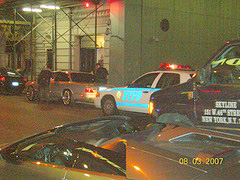Data-Driven Traffic Enforcement Saves Lives. NYPD Only Halfway There.
 Photo: scubaham/Flickr
Photo: scubaham/FlickrWith good data and targeted traffic enforcement, police departments around the country are saving lives. The Data Driven Approach to Crime and Traffic Safety policing system, or DDACTS, run by the National Highway Transportation Safety Administration, is reducing crashes by putting officers where they need to be to address the traffic violations most likely to lead to injury and death.
Though the NYPD recently reinstated a program to focus traffic enforcement on hot spots for crashes, DDACTS includes a component that street safety advocates say is still missing here in New York: focusing on the most dangerous types of traffic crime.
Through DDACTS, the feds provide technical assistance to local police departments about how to reduce both traffic crashes and overall crime. After using geospatial data to identify "hot-spots" prone to both traffic crashes and criminal activity, the police then focus enforcement in those areas, particularly by enforcing traffic laws.
The Metro Nashville Police Department, for example, identified impaired
driving as a leading cause of crashes at local hot-spots. By focusing
enforcement on that issue in those locations — the number of arrests
for impaired driving increased from 3,242 to 5,995 per year — the number
of fatal crashes annually decreased from 77 to 67.
"If you have an area that has a high incidence of alcohol-involved crashes," said Earl Hardy of NHTSA’s Enforcement and Justice Services Divison, "you need to address alcohol enforcement. The same with speeding or any other causative factor."
The results have been impressive, according to Hardy, with double-digit declines in the rates of traffic crashes, injury-causing crashes, and crime in targeted areas. "We’re used to seeing some declines," said Hardy, "but this is like putting it on steroids." Secretary of Transportation Ray LaHood gave the program a big shout-out on his blog last month.
NYPD recently took a big step toward this approach to saving lives by restoring the technique known as accident-prone location deployment. This protocol, which had first been implemented in the 1990s, assigns traffic safety officers to the streets and intersections with the highest rates of overall crashes and fatal crashes. (According to the Transportation Alternatives report Executive Order, when the technique was first applied, an intersection received one point for each crash, two points for a crash with an injury, and three points for a fatal crash; the police added up the points and deployed their officers accordingly.)
Accident-prone location deployment had disappeared by the end of the tenure of NYPD Chief of Transportation Michael Scagnelli, according to T.A.’s Jessie Singer. After James Tuller replaced him in June 2009, however, accident-prone location deployment was reinstated.
So far, the NYPD hasn’t taken up the other half of the DDACTS formula, which would mean training officers’ eyes on the most dangerous violations.
"We’re glad to see the NYPD recognizes that targeting crash-prone locations can save lives," said T.A. executive director Paul Steely White. "This is major progress, and we applaud their decision to do so. But the other missing piece is to give similar attention to crash-prone violations." For example, Executive Order reported that while speeding was a factor in more than 39 times as many crashes as using a cell phone behind the wheel, the department issued less than half as many speeding summonses as cell phone summonses.
The lesson of DDACTS is that sustained and accurately-targeted enforcement of the causes of traffic crashes saves lives. In New York, police are focusing enforcement in the right places, but missing the mark when it comes to the deadliest traffic violations. NYPD did not respond to a request for comment.





